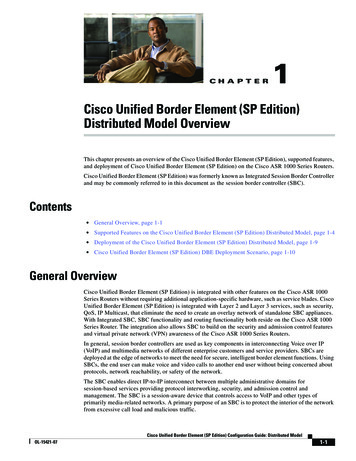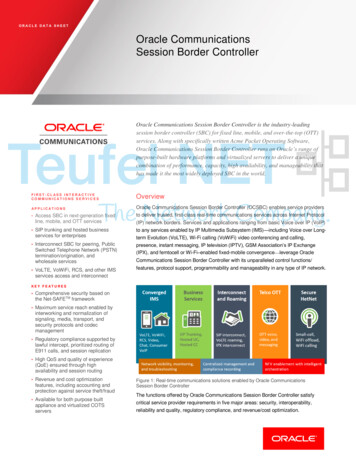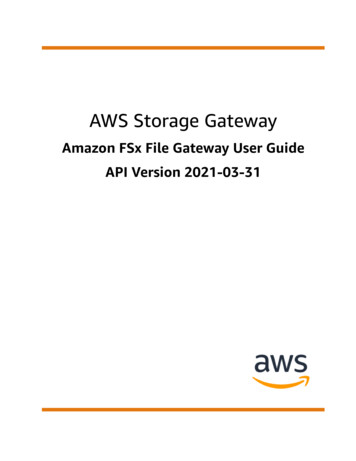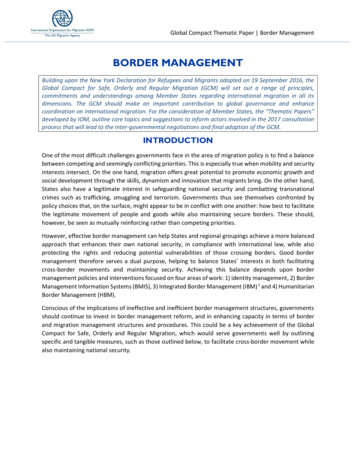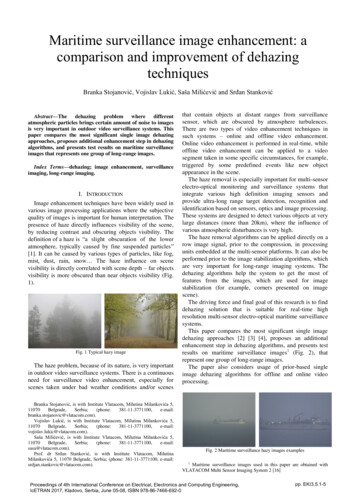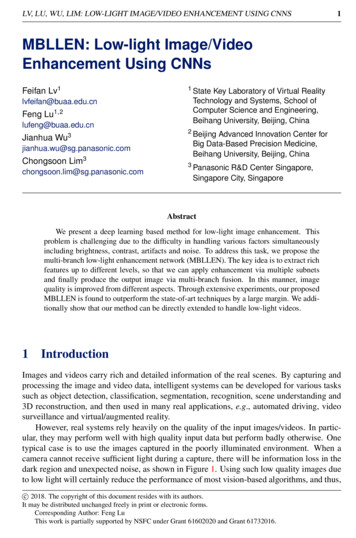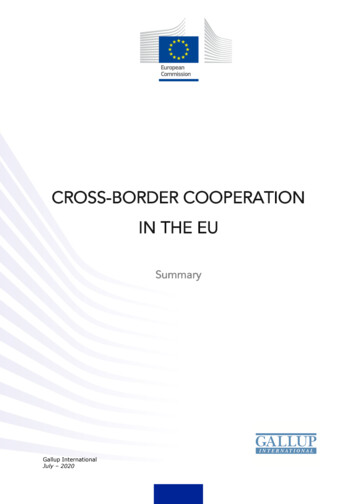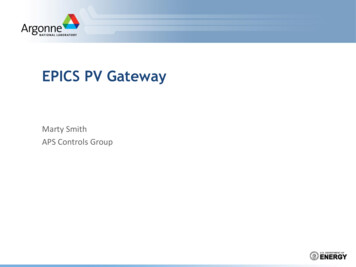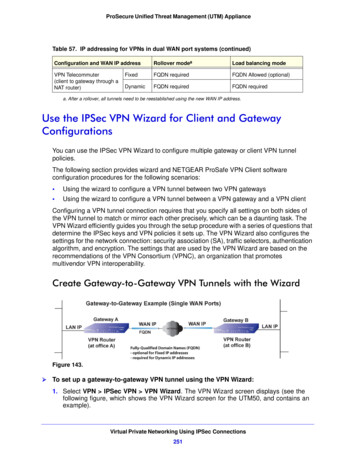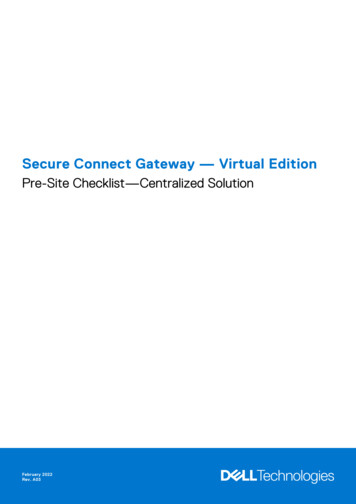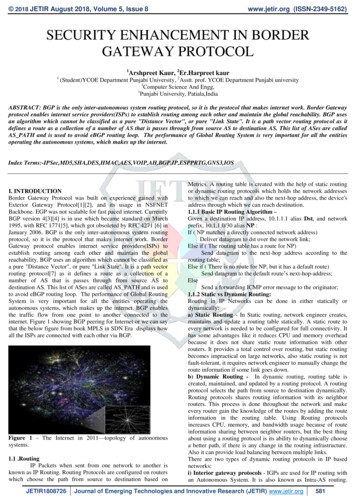
Transcription
2018 JETIR August 2018, Volume 5, Issue 8www.jetir.org (ISSN-2349-5162)SECURITY ENHANCEMENT IN BORDERGATEWAY PROTOCOL1Arshpreet Kaur, 2Er.Harpreet kaur1(Student)YCOE Department Punjabi University, 2Asstt. prof. YCOE Department Punjabi university1Computer Science And Engg,1Punjabi University, Patiala,IndiaABSTRACT: BGP is the only inter-autonomous system routing protocol, so it is the protocol that makes internet work. Border Gatewayprotocol enables internet service providers(ISPs) to establish routing among each other and maintain the global reachability. BGP usesan algorithm which cannot be classified as a pure "Distance Vector", or pure "Link State". It is a path vector routing protocol as itdefines a route as a collection of a number of AS that is passes through from source AS to destination AS. This list of ASes are calledAS PATH and is used to avoid eBGP routing loop. The performance of Global Routing System is very important for all the entitiesoperating the autonomous systems, which makes up the internet.Index SPPRTG,GNS3,IOSI. INTRODUCTIONBorder Gateway Protocol was built on experience gained withExterior Gateway Protocol[1][2], and its usage in NSFNETBackbone. EGP was not scalable for fast paced internet. CurrentlyBGP version 4[3][4] is in use which became standard on March1995, with RFC 1771[5], which got obsoleted by RFC 4271 [6] inJanuary 2006. BGP is the only inter-autonomous system routingprotocol, so it is the protocol that makes internet work. BorderGateway protocol enables internet service providers(ISPs) toestablish routing among each other and maintain the globalreachability. BGP uses an algorithm which cannot be classified asa pure "Distance Vector", or pure "Link State". It is a path vectorrouting protocol[7] as it defines a route as a collection of anumber of AS that is passes through from source AS todestination AS. This list of ASes are called AS PATH and is usedto avoid eBGP routing loop. The performance of Global RoutingSystem is very important for all the entities operating theautonomous systems, which makes up the internet. BGP enablesthe traffic flow from one point to another connected to theinternet. Figure 1 showing BGP peering for Internet or we can saythat the below figure from book MPLS in SDN Era displays howall the ISPs are connected with each other via BGP.Figure 1 - The Internet in 2011—topology of autonomoussystems.1.1 .RoutingIP Packets when sent from one network to another isknown as IP Routing. Routing Protocols are configured on routerswhich choose the path from source to destination based onJETIR1808726Metrics. A routing table is created with the help of static routingor dynamic routing protocols which holds the network addressesto which we can reach and also the next-hop address, the device'saddress through which we can reach destination.1.1.1 Basic IP Routing Algorithm –Given a destination IP address, 10.1.1.1 alias Dst, and networkprefix, 10.1.1.0/30 alias NP :If ( NP matches a directly connected network address)Deliver datagram to dst over the network link;Else if ( The routing table has a route for NP)Send datagram to the next-hop address according to therouting table;Else if ( There is no route for NP, but it has a default route)Send datagram to the default route’s next-hop-address;ElseSend a forwarding ICMP error message to the originator;1.1.2 Static vs Dynamic Routing:Routing in IP Networks can be done in either statically ordynamically:a) Static Routing - In Static routing, network engineer creates,maintains and update a routing table statically. A static route toevery network is needed to be configured for full connectivity. Ithas some advantages like it reduces CPU and memory overheadbecause it does not share static route information with otherrouters. It provides a total control over routing, but static routingbecomes impractical on large networks, also static routing is notfault-tolerant, it requires network engineer to manually change theroute information if some link goes down.b) Dynamic Routing - In dynamic routing, routing table iscreated, maintained, and updated by a routing protocol. A routingprotocol selects the path from source to destination dynamically.Routing protocols shares routing information with its neighborrouters. This process is done throughout the network and makeevery router gain the knowledge of the routes by adding the routeinformation in the routing table. Using Routing protocolsincreases CPU, memory, and bandwidth usage because of routeinformation sharing between neighbor routers, but the best thingabout using a routing protocol is its ability to dynamically choosea better path, if there is any change in the routing infrastructure.Also it can provide load balancing between multiple links.There are two types of dynamic routing protocols in IP basednetworks:i) Interior gateway protocols - IGPs are used for IP routing withan Autonomous System. It is also known as Intra-AS routing.Journal of Emerging Technologies and Innovative Research (JETIR) www.jetir.org581
2018 JETIR August 2018, Volume 5, Issue 8www.jetir.org (ISSN-2349-5162)Enterprises, service providers use IGP in their internal networks.Various IGPs include Routing Information Protocol(RIP),Enhanced Interior Gateway Routing Protocol(EIGRP), OpenShortest Path First(OSPF), and Intermediate System toIntermediate System(IS-IS).ii) Exterior gateway protocols - EGP is used for routing betweenautonomous systems. It is also known as Inter-AS routing. Serviceproviders and large enterprises interconnect using EGP. Onlyprotocol that comes under this category is Border GatewayProtocol(BGP). It is also the protocol that makes Internet work orwe can say that it is the official protocol of the Internet.Figure 1.4 - IBGP/EBGP RelationshipFigure 1.1 - IGP-EGP Topology1.2 Border Gateway Protocol – Border Gateway Protocol is theonly exterior Gateway Protocol in the world at present. It is alsoknown as Internet’s Protocol. It comes in both IPv4 and IPv6versions. Currently BGPv4 is used in IPv3. Following are thecharacteristics of Border Gateway Protocol :1.3 Characteristics of Border Gateway Protocol BGP is the only exterior gateway protocol(EGP) used inrouting between different Autonomous Systems. BGP is a path vector routing protocol which is suited forstrategic routing policies. eBGP is used for neighborship between different autonomoussystems. For example BSNL uses AS 9829 and Bharti Airteluses AS 9498. Neighborship and route sharing between thesetwo ISPs is done via eBGP. iBGP is used between internal neighbors i.e. bgpneighborship between routers which are part of the sameautonomous system. For best path selection[12] towards destination, BGP[13] usesseveral attributes. Most of the attributes are open standard,while some are proprietary. BGP uses TCP port 179[14][15] to establish connectionsbetween neighbors. Incremental Updates Classless Inter Domain Routing(CIDR)1.4 BGP Terminology Autonomous System - set of routers under a single technicaladministration. IGP is used inside an Autonomous system forrouting purposes, while BGP is used to share routinginformation between different autonomous system. Peers(neighbors) - Two routers running BGP, exchangingroute information are called peers or neighbors. External BGP(eBGP) - Two routers belonging to differentASes running BGP to share routing information. Internal BGP(iBGP) - Two routers belonging to same ASrunning BGP to share routing information. Path Attributes - Metrics used to BGP to select the best pathto reach destination.II. TOOLS AND SIMULATION PARAMETERS2.1 Graphic Network Simulator(GNS3) - GNS3 is an alternativesoftware tool to using real computer labs for network engineers,or people studying for Cisco CCNA, CCNP and CCIE as well asJuniper certifications such as JNCIA, JNCIS and JNCIE. It runsthe original Cisco IOS and Juniper's JUNOS images which areused in Cisco and Juniper Routers. GNS3, also is widely used toexperiment features or to check configurations that needs to bedeployed later on real devices. We can also connect GNS3 Labswith real devices. It also includes tools like Wireshark, which canbe used as a packet analyzer and Solarwinds Tools which can beused to monitor network performance while capturing packet dataon Wireshark. Below Figure 2.1 shows View of Graphic NetworkSimulation.Figure 2.1 - View of Graphic Network Simulator2.2 Wireshark(version 2.5) - Wireshark is the world's mostpopular and advanced network network analyzer. It is the defacto standard across many industries and educational institutions.It has features like "deep inspection of hundreds of protocols, livecaptures and offline analysis, It has the most powerful displayfilters in the industry. It works well in conjunction with GNS3. Itcan read live data from Ethernet, IEEE 802.11, PPP/HDLC,ATM, Bluetooth, USB, Token Ring, Frame Relay and others. Italso has decryption support for many protocols that includesIPsec, ISAKMP, Kerberos, SNMPv3, SSL/TLS, WEP, andWPA/WPA2. Below Figure 2.2 shows Packet capturing inWireshark Packet Analyzer.Figure 2.2 - Packet capturing in Wireshark Packet Analyzer.JETIR1808726Journal of Emerging Technologies and Innovative Research (JETIR) www.jetir.org582
2018 JETIR August 2018, Volume 5, Issue 82.3 PRTG - PRTG Network Monitor (PRTG, successor ofPaessler Router Traffic Grapher) is network monitoring softwarefrom Paessler AG. PRTG runs on Windows and monitors networkavailability and network usage using SNMP, Packet Sniffing,WMI, IP SLAs and Netflow and various other protocols. BelowFigure 2.3 shows PRTG Network Monitorwww.jetir.org (ISSN-2349-5162)Topology that I used for my testing work is :Figure 3.1 - BGP topology used in GNS3Figure 2.3 - shows PRTG Network MonitorIII. Simulation ParametersSimulatorLink BandwidthLink TypeRouted ProtocolsType of trafficNumber of RoutersRouters UsedIP PhonesPacket AnalyzerMonitoring ToolGraphic NetworkSimulator(GNS3)10 MbpsEthernetIPv4 and IPv6Data and Voice10 GNS3 Virtual Routers 1Physical Cisco 2821Cisco 2691 and Cisco 2821Cisco 7961WiresharkPaessler Router TrafficGrapher(PRTG)3.1 Behavior Analysis of BGP routing protocol with IPv4 andIPv6BGP is the protocol of the internet, since early 1990's, BGP is theonly protocol used to share routes between different autonomoussystems. Major priority was always towards the scalability of theBorder Gateway Protocol from its starting days, Apart fromscalability, other parameters like performance and security arealso quite big factors in modern Internet. Bandwidths areincreasing day by day, with all the major ISPs around the worldlike AT&T, Sprint, Verizon, British Telecom etc have their corenetwork connected at 100 Gbps. Even though BGP is made as aslow protocol for a reason, but still there are someimplementations like MPLS VPNs where Multi Protocol BGP isused, a good performance[9] is needed between Provider Edgerouters that includes fast convergence. Security is the major issuethat impacts large number of ISPs everyday, problems like RouteLeaking, Plain Traffic over Internet, Distributed Denial of ServiceAttacks make internet insecure and ISPs faces humongous issuesif the design has some problem or security methods not deployedto tackle above issues. In this chapter, problems associated withthe BGP and solutions to them are given. Below figure 3.1 is oneof the topology used for research work :-Problem 1 - Plain Internet vs IPsec based InternetProblem 1 lies in comparing Internet traffic with no securityapplied and with IPSec used to encrypt traffic. We all know thatIPSec[10][11][12] is a suite of security protocols, it is to security,what TCP/IP is for routing. Still it is not used widespread tosecure internet traffic by ISP and is mainly used in Virtual PrivateNetworks. In the testing topology shown in Figure 3.1, BhartiAirtel is connected with a Cloud3, which has virtual interface VMNet 1 connected with it, that interface also has Cisco IPCommunicator connected with it. Cisco IP Communicator is asoft IP phone by Cisco Systems used in Real World VoIPcommunications. Below is the graphic of Cisco IP Communicatorused :Figure 3.2 - Cisco Soft IP PhoneOn the other end, Rogers in Canada is connected with a cloudwhich is using LAN interface of laptop and a physical CiscoRouter 2821 is connected with the LAN interface of Laptop,which has further an Cisco 7961 IP Phone connected with it. Allthe VoIP configuration is done on Cisco 2821 router and is therouter that manages the VoIP calls between Bharti and Rogers.VoIP calls can easily be tapped using sniffers like Wireshark asshown below :-Figure 3.3 - Decoding UDP TrafficJETIR1808726Journal of Emerging Technologies and Innovative Research (JETIR) www.jetir.org583
2018 JETIR August 2018, Volume 5, Issue 8Figure 3.4 - Decoding UDP Traffic to RTPwww.jetir.org (ISSN-2349-5162)Figure 3.8 - CPU utilization of Rogers Router during VoIP callwith plain traffic.Figure 3.5 - RTP Stream AnalysisFigure 3.8 - RTP Delay Graph during VoIP call at RogersAbove graph taken from Wireshark shows that average delayduring the voice call on internet takes an average of 50-60 ms onplain internet with no IPSec applied.Figure 3.6 - Making the Wireshark ready to play captured VoIPtrafficFigure 3.9 - RTP Jitter Graph at Rogers during VoIP callFigure 3.7 - Capturing VoIP and playing it on Wireshark RTPPlayerAs the above figures show, capturing voice traffic is very easytask and if some one on internet does a MITM attack over theinternet on your company voice data, then it can be veryvulnerable . As VoIP is nothing but voice travelling over InternetProtocol, therefore IPSec can be used to secure the VoIP relateddata so that it cannot be tapped. IPSec is good, but it can beprocessor intensive also, therefore it cannot be implemented forwhole internet traffic as it may take the internet down as most ofthe routers will go down because of the CPU load it takes toencrypt and decrypt packets and routers will get less time toforward the IP packets based on the best path, which is their primework. Below figure 3.8 is the Rogers router cpu processingcapture with no ipsec applied, it shows that only 5% of CPU isutilized :JETIR1808726Above graph created from Wireshark shows that average jitterbetween RTP packets during VoIP call is around 6-7ms.BGP Traffic with IPSec applied is compared below withdifferent combinations of Security combinations :Combination - 1 - SHA - AES 128 - DH5Figure 3.10 - CPU Load increase, when IPSec is applied betweenBharti Airtel and Rogers trafficAbove graph shows that CPU Utilization begin to increase oneIPSec is applied. In the above graph IPSec is applied betweenBharti Airtel and Rogers traffic and the edge routers of both theISPs have their CPU load begin to increase. In 8 minutes, CPUload increased from 10 percent to 16 percent with same amount oftraffic.In the below graph, Wireshark capture is shown of ESP packetsfrom Bharti Airtel or Rogers, Canada, As all the traffic isencapsulated within ESP, therefore it is nearly impossible to tapJournal of Emerging Technologies and Innovative Research (JETIR) www.jetir.org584
2018 JETIR August 2018, Volume 5, Issue 8www.jetir.org (ISSN-2349-5162)the VoIP traffic and then decode the RTP traffic using WiresharkPlayer.Figure 3.11 - IPSec packets captured in WiresharkBelow figure 3.12 shows cpu utilization rate with combination ofAES 128, SHA and DH5 algorithm applied.Figure 3.14 - High CPU Load on Rogers RouterFigure 3.15 - Packet drop as traffic is increasing at a rapid rate.The impact of rise in CPU load can be seen in the above graphfrom PRTG. As the internet traffic grows rapidly and IPSec isapplied on the same router that holds the internet routing tableshows the increase in packet loss.Figure 3.12 - CPU Load on Rogers Router during IPSeccombination 1 appliedCombination - 2 - SHA - AES 256 - DH5Figure 3.13 - CPU Utilization Rise during combination 2 of IPSecapplied between the trafficAbove is the CPU Load graph from PRTG showing rise in CPUload on Rogers router accepting packets from airtel and other ISPsover the internet and performs encryption and decryption on CiscoRouter. It shows that around 14 percent load is increased onCPU over 8 minutes, which is pretty high and if traffic isincreased in constant manner then it can reach its full utilization inaround 50 minutes. Combination used for the above graph is AES256, SHA and DH5.Also the below figure shows the utilization of cpu resources riseby applying ipsec. Command used to view the rise in CPUresource utilization is "show processes cpu sorted 5sec". Theoutput showed pretty clearly that it utilizes much higher cpuresources when compared with the last combination of AES 128,SHA and DH5 and a huge difference between the plain traffic andthis combination. ISP routers that holds the internet routing tablecan have a severe impact on them if IPSec is implemented onthem. Its much better security practice if IPSec is deployed onsome other device and let the routers that hold the full internetrouting table do the work of forwarding traffic on the basis of dataplane. Therefore BGP can only do the control plane work and dataplane is done by the Forwarding Information Base or CiscoExpress Forwarding in case of routers and IPSec work is totallyseparated from the control plane and data plane on routing tablesholding Internet Routing tables.JETIR1808726Figure 3.16 - Graph showing decline in CPU Load as IPSec isremoved.As i disable the IPSec on the Rogers and Bharti Airtel router, thecpu load started to decrease at a rapid pace. Also the packet loss isalso decreased and almost eliminated along with faster response.Figure 3.17 - Figure showing decline in echo reply from Bharticonnected PC to Rogers when IPSec is disabled.Journal of Emerging Technologies and Innovative Research (JETIR) www.jetir.org585
2018 JETIR August 2018, Volume 5, Issue 8PROPOSED SOLUTION FOR PROBLEM 1 - There is aproposed solution to this kind of problem where CPU getsexhausted by large number of encryption and decryption relatedtasks. To overcome the problem that internet routers face withIPSec because of all traffic is encrypted rather than the importantone only, below algorithm with lower level encryption can beused, where encryption bits are lowered to 56 bits from 256 bits.A internet-rtrB voip-lev-1-enterpriseC voip-lev-2-enterpriseD non-enterprise-trafficE Customer encrypted trafficIf a has d in fastethernet0/0 :Then traffic will be forwarded to next-hop without beingencryptedElif a has c in fastethernet0/0 :Then perform a 56 bit encryption on all the incomingVoice/Video Packets and forward them to next-hop routerElif a has b in fastethernet0/0 :Then perform a 128 bit encryption on all the incomingVoice/Video packets and forward them to next-hop-routerElseSend traffic will be forwarded to next-hop without beingencryptedBelow is the result of the above algorithm :Figure 3.18 – An improved result with new method.Problem 2 - Route Leaking :Route leaking or Route Hijacking is a very severe problem onInternet, where the routes of one ISP are advertised by some otherISP, which can be intentional or by mistake. If the ISP thatadvertises false routes into the BGP internet table has better pathto customer than the real one or enters a longer prefix than theoriginal one, then the traffic towards that routes are either blackholed or goes through the false ISP, that adds the delay. Below isthe screenshot of route leaking in the regions as per August 4,2016 of bgpstream.com, which is the website that monitors theroute leaks continuously using the API of BGPMON.net :-Figure 3.19 – bgpstream.com showing continuous route leakingin BGP.There are route servers of all the major Internet Service Providersaround the world that peer with BGP internet routers of the ISPs.These route servers are mostly on the Linux based machinesrunning Red Hat Enterprise Linux or SUSE Linux etc withJETIR1808726www.jetir.org (ISSN-2349-5162)Quagga running over it. Large Service providers like AT&T,Bharti Airtel, Vodafone, Colt, British Telecom etc have theirroute servers where the full internet routing table is synced withall their internet routers. That route server can be used as acontroller as it has all the routes stored in it.What can be done isthat we can use a Linux Based route-server with Quagga runningover it. Red Hat Enterprise Linux can sync with all other routersand can work as a controller type machine as it has all the internetroutes present in its routing table. With all the routes present inthe routing table,there is just one point from where all the routesfrom the service provider is controlled. This can bring the entirenew revolution in the service providers, where a single controlleris needed to control all the traffic and there is only need of asingle control plane and all other devices can act as data orforwarding plane. This can also be said as Software DefinedNetworking, the revolutionary approach to the network Industryby Google and Stanford University under their clean slate project.Below are the commands to make red hat enterprise linux as BGPcompatible :# yum install quagga# setsebool -P zebra write config 1# cp quagga/zebra.conf# systemctl start zebra# systemctl enable zebra# cp /quagga/bgpd.conf# systemctl start bgpd# systemctl enable bgpd# vtyshRouter-A# configure terminalRouter-A(config)# log file /var/log/quagga/quagga.logRouter-A(config)# exitBelow is the proposed solution pseudocode that can be doneon the controller :Suggested Algorithm pseudocode :x Routing Tabley Original Route entryz Longer prefixif y [x] && routes in [y] is reachable :print y is best routeelif y [x] && z enters bgp table with different originating ASthan yprint y is best route and route leak occured by zelif y z [x] && routes in [z] are reachable from [yz] withsame originating AS :print z is best route for z prefixelse y z [x] && routes in [z] are unreachable from [z] andreachable from [y]print y is best route for z prefixExample is given below with the following topology :-Figure 3.20 - Route Leaking topology used for exampleSuppose in the above example, Rogers originated route11.1.0.0/16 and Bharti Airtel is getting routes for 11.1.0.0/16 viaBritish Telecom. Traffic from Airtel users and Rogers 11.1.0.0 ishaving no problem and has a constant flow.Vodafone, on the other hand, by mistake, advertised 11.1.1.0/24 intheir network, which is a longer prefix than 11.1.0.0/16, thereforeJournal of Emerging Technologies and Innovative Research (JETIR) www.jetir.org586
2018 JETIR August 2018, Volume 5, Issue 8if other ISPs on the internet receives this route, they make11.1.1.0/24 as the best route from 11.1.1.0 - 11.1.1.255.Figure 3.21 - Route Leak problem occured because Vodafone bymistake advertises Rogers route.What my theoretical method in the form of pseudocode will do isthat it will helps in reduction of Route Leaking problems whichcan make ISPs much secure than they are today. Following imagedisplays what would happen if my algorithm would be used :-Figure 3.22 - Route Leaking preventionExample pseudocode x Routing Tabley 11.1.0.0/16z 11.1.1.0/24if y [x] && routes in [y] is reachable :print y is best routeelif y [x] && z enters bgp table with different originating ASthan yprint y is best route and route leak occured by zelif y z [x] && routes in [z] are reachable from [yz] withsame originating AS :print z is best route for z prefixelse y z [x] && routes in [z] are unreachable from [z] andreachable from [y]print y is best route for z prefixIV. CONCLUSIONBGP is the protocol that is used to share routes between theInternet Service Providers. It is the only exterior gateway routingprotocol in the world. With Internet of Things and cloudcomputing, security is becoming a big concern with BorderGateway Protocol. Security can never be fully achieved and thereis no such thing as 100 percent security in any industry. In ourbase paper, IPSec was used to make all internet traffic encryptedwhich can be severe in terms of delay and cpu utilization ofrouters, delay on internet can make internet slow and it will notwork for application where benign traffic is needed and alsoresults in packet loss. A better solution is to use low levelencryption on selective traffic and let the plain traffic continue forunimportant IP traffic. It has show significant improvement andreduces the CPU Utilization level from 14 percent to 1 percent.Route Leaking is another big problem that internet is facing fromlast many years, a proposed solution to that is to use route serveras controller, which can control the routes using the proposedalgorithm and can act as a single primary control plane and allother internet devices at ISP can act as data or forwarding planeand can act according the control plane which is running theproposed algorithm to mitigate route leaking.JETIR1808726www.jetir.org (ISSN-2349-5162)V.REFERENCES[1]K. Lougheed, Y. Rekhter, ―A Border Gateway Protocol ‖,Request for Comments: 1105, Internet Engineering Task Force,June 1989.[2] K. Lougheed and Y. Rekhter,‖BGP Version 2‖, Request forComments: 1163, Internet Engineering Task Force, June 1990[3]J. Honig, D. Katz, M. Mathis, Y. Rekhter,‖Application of theBorder Gateway Protocol in the Internet‖, Request for Comments:1164, Internet Engineering Task Force, June 1990[4]Y. Rekhter and K. Lougheed, ―A Border Gateway Protocol 3(BGP-3)‖, Request for Comments: 1267, Internet EngineeringTask Force, October 1991.[5]Y. Rekhter and T. Li, ―A Border Gateway Protocol 4 (BGP4)‖, Request for Comments: 1771, Internet Engineering TaskForce, March 1995.[6]Y. Rekhter and T. Li, ―A Border Gateway Protocol 4 (BGP4),‖ Request for Comments: 4271, Internet Engineering TaskForce, January 2006.[7]D. Meyer and K. Patel, ―BGP Protocol Analysis‖,Request forComments: 4274, Internet Engineering Task Force, January 2006.[8] D. McPherson and K. Patel,‖Experience with BGP-4Protocol ‖, Request for Comments: 4277, Internet EngineeringTask Force, January /web/about/security/intelligence/protecting bgp.html[11]V. Gill, J. Heasley, D. Meyer, P. Savola, Ed., C.Pignataro,‖ The Generalized TTL Security Mechanism(GTSM)‖, Request for Comments: 5082, Internet EngineeringTask Force, October 2007.[12] A. Heffernan,‖Protection of BGP Sessions via the TCP MD5Signature Option‖, Request for Comments: 2385, InternetEngineering Task Force, august 1998.[13] R. Bonica, B. Weis, S. Viswanathan, A. Lange, O.Wheeler,‖ Authentication for TCP-based Routing andManagement Protocols draft-bonica-tcp-auth-04‖, Internet draft,Internet Engineering Task Force, February 2006.[14]Heng Yin, Bo Sheng, Haining Wang and JianpingPan,‖Securing BGP with keychain based signatures‖,IEEE,2007,International Workshop on Quality of Service, pp.154-163[15]Stephen Kent, Charles Lynn, and Karen Seo,”SecureBorder Gateway Protocol‖, IEEE Journal on Selected areas inCommunications,Vol – 18,Issue: 4,April 2000,pp.582 - 592Journal of Emerging Technologies and Innovative Research (JETIR) www.jetir.org587
2018 JETIR August 2018, Volume 5, Issue 8 www.jetir.org (ISSN-2349-5162) JETIR1808726 Journal of Emerging Technologies and Innovative Research (JETIR) www.jetir.org 581 SECURITY ENHANCEMENT IN BORDER
